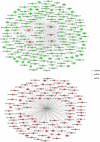Integrated analysis of long non-coding RNA-microRNA-mRNA competing endogenous RNAregulatory networks in thromboangiitis obliterans
- PMID: 34787068
- PMCID: PMC8810094
- DOI: 10.1080/21655979.2021.2002497
Integrated analysis of long non-coding RNA-microRNA-mRNA competing endogenous RNAregulatory networks in thromboangiitis obliterans
Abstract
Thromboangiitis obliterans (TAO) is a non-atherosclerotic, segmental, chronic vascular inflammatory disease. Our aim was to explore the underlying mechanisms of long non-coding RNA (lncRNA)-related competing endogenous RNAs (ceRNAs) in TAO. Six blood samples were collected from patients with TAO and healthy individuals (three for each category). Total RNA was extracted from the blood of each participant and sequenced. Differentially expressed lncRNAs (DE-lncRNAs) and miRNAs (DE-miRNAs) were screened, and ceRNA networks associated with TAO were constructed. Thereafter, the genes in the ceRNA network were subjected to functional analyses. Finally, a ceRNA relationship (lncRNA NEAT1-hsa-miR-1-3p-mRNA GNA12) was selected for further validation. Analysis revealed that 347 DE-lncRNAs (150 downregulated and 197 upregulated) and 16 DE-miRNAs (3 downregulated and 13 upregulated) were identified in TAO. Further, TAO-associated ceRNA networks, which included 219 lncRNAs, 6 miRNAs, and 53 mRNAs, were proposed and subjected to gene annotation and pathway analysis. Additionally, NEAT1 and GNA12 levels were significantly upregulated, while miR-1-3p levels were evidently downregulated in TAO patients, as compared with those in healthy controls. Dual luciferase reporter assays showed that NEAT1, miR-1-3p, and GNA12 interacted with each other. We report potential TAO-associated ceRNA regulatory networks and suggest activation of NEAT1/miR-1-3p/GNA12 signaling as a novel mechanism for TAO progression.
Keywords: Thromboangiitis obliterans; ceRNA network; lncRNA; miRNA.
Conflict of interest statement
The authors declare that the research was conducted in the absence of any commercial or financial relationships that could be construed as a potential conflict of interest.
Figures





Similar articles
-
Integrated analysis of lncRNA-miRNA-mRNA ceRNA network in squamous cell carcinoma of tongue.BMC Cancer. 2019 Aug 7;19(1):779. doi: 10.1186/s12885-019-5983-8. BMC Cancer. 2019. PMID: 31391008 Free PMC article.
-
Non-coding RNA Identification in Osteonecrosis of the Femoral Head Using Competitive Endogenous RNA Network Analysis.Orthop Surg. 2021 May;13(3):1067-1076. doi: 10.1111/os.12834. Epub 2021 Mar 21. Orthop Surg. 2021. PMID: 33749138 Free PMC article.
-
Excavating novel diagnostic and prognostic long non-coding RNAs (lncRNAs) for head and neck squamous cell carcinoma: an integrated bioinformatics analysis of competing endogenous RNAs (ceRNAs) and gene co-expression networks.Bioengineered. 2021 Dec;12(2):12821-12838. doi: 10.1080/21655979.2021.2003925. Bioengineered. 2021. PMID: 34898376 Free PMC article.
-
The Role of lncRNA-miR-26a-mRNA Network in Cancer Progression and Treatment.Biochem Genet. 2024 Jun;62(3):1443-1461. doi: 10.1007/s10528-023-10475-w. Epub 2023 Sep 20. Biochem Genet. 2024. PMID: 37730965 Review.
-
LncRNA/CircRNA-miRNA-mRNA Axis in Atherosclerotic Inflammation: Research Progress.Curr Pharm Biotechnol. 2024;25(8):1021-1040. doi: 10.2174/0113892010267577231005102901. Curr Pharm Biotechnol. 2024. PMID: 37842894 Review.
Cited by
-
Non-coding RNAs regulating endothelial progenitor cells for venous thrombosis: promising therapy and innovation.Stem Cell Res Ther. 2024 Jan 2;15(1):7. doi: 10.1186/s13287-023-03621-z. Stem Cell Res Ther. 2024. PMID: 38169418 Free PMC article. Review.
-
Exosome-transmitted miR-3124-5p promotes cholangiocarcinoma development via targeting GDF11.Front Oncol. 2022 Aug 1;12:936507. doi: 10.3389/fonc.2022.936507. eCollection 2022. Front Oncol. 2022. PMID: 35978818 Free PMC article.
References
-
- Olin JW. Thromboangiitis obliterans (Buerger’s disease). N Engl J Med. 2000;343(12):864–869. - PubMed
Publication types
MeSH terms
Substances
LinkOut - more resources
Full Text Sources
